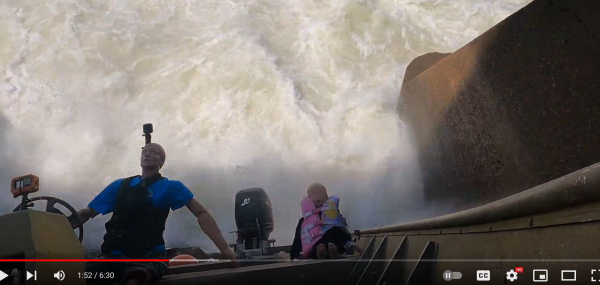
Tennessee WRA sent a jon boat holding two dummy anglers through one of the state’s big hydro-electric dams to illustrate what can happen to careless anglers—check it out here! (TWRA)
By Frank Sargeant
Frankmako1@gmail.com
Cold weather is a time when anglers on America’s major river systems like to take advantage of the many giant hydroelectric dams that act as fish magnets for species like walleye, sauger, smallmouths, white bass and landlocked stripers drawn to the flow and the constant food stream that boils through the dam gates.
It’s also a time when there are occasional tragedies among the anglers who get too close to the awesome power of the falling water.
Per Tennessee Wildlife Resources, over the past decade there have been 17 fatalities caused by boaters getting caught in and around the spillways of hydroelectric dams in Tennessee. Pickwick, Cheatham, and Loudon dams all had multiple fatalities.
There’s danger both above and below the dams, but that above the dam is a bit more insidious—you can get in trouble before you realize what’s happening.

Once your boat is caught by the force of the falling water, there’s no escape—the pull of the water is too great. (TWRA)
I’ve never had a truly close call, but I’ve been in the neighborhood.
A couple years ago a buddy and I were throwing crankbaits at the riprap on the embankments of Guntersville Dam, and catching some really nice largemouths now and then, when all of a sudden I realized the boat was moving backwards and I was running the trolling motor forward.
The current going through the gates had slowly been easing us back toward the spillway, and as we got closer the pull had gotten stronger and stronger. I kicked the troller up to high and stood on it—and we still went backwards!
It took us about 2 seconds to jump down into the seats, touch off the outboard and get the heck out of there, no harm done except to my opinion of my captaining skills.
But afterwards we thought about what might have happened if my aging outboard had decided not to start immediately, which it sometimes did. I’ve since given the spillway a wide berth, though I still do occasionally fish the far end with crankbaits pre-spawn.
The worst disasters usually occur for boaters pulled through the gates from above, but plenty of boaters get capsized in the turbulent waters below the major structures, as well.

The crushing force of the water boiling through the gates is also very dangerous below the dam, where unwary boaters who get to close can be pulled in or flipped over. (TWRA)
The Wilson Dam, at the head of Pickwick Lake, is a famed spot for catching huge cold weather smallmouths, but it’s also a dangerous piece of water, littered with boulders. When the current is running strong, there are numerous boils and hydraulics that can easily knock an angler off the casting deck or even capsize a small boat. If you fall into that cold, fast water—particularly without a PFD around your chest—you’re in deep trouble.
To ensure a safe outing, TWRA recommends following these safety tips:
- Observe and Follow All Posted Warnings and Buoys: Pay attention to warning signs, restricted areas, and barrier buoys that indicate hazardous zones.
- Avoid Swift Currents: Currents near dams can be unpredictable and dangerous. Avoid getting too close to dam structures or spillways, both above and below the structure.
- Wear a Life Jacket: Always wear a properly fitting, Coast Guard-approved life jacket when boating, fishing, or recreating near water, and particularly around dams.
- Stay Alert for Changes in Water Levels: Water levels near dams can rise or fall unexpectedly due to dam operations. Be prepared to move to safer areas if needed, and keep watch for signals of changing flow.

Here’s what a boat looks like after it has been through a dam. Make sure it doesn’t happen to you by following the tips from Tennessee Wildlife Resources. (TWRA)
To these tips, we’d also add “Don’t Attempt to Anchor in Fast Water”. If your anchor grabs on to bottom, there’s a very good chance the flow of the water will drive the bow down and before you know it, your boat will have sunk and you’ll be floating down river along with all your loose gear. Control the boat with your trolling motor, and if you can’t, move away from the fast water to other fishing spots.
While there’s wonderful fishing to be had in winter around the big rivers of the southeast, there are also some dangers that have to be taken into account if you’re going to stay safe.
See the TWRA video here: https://www.youtube.com/watch?v=_5geWJLgExc